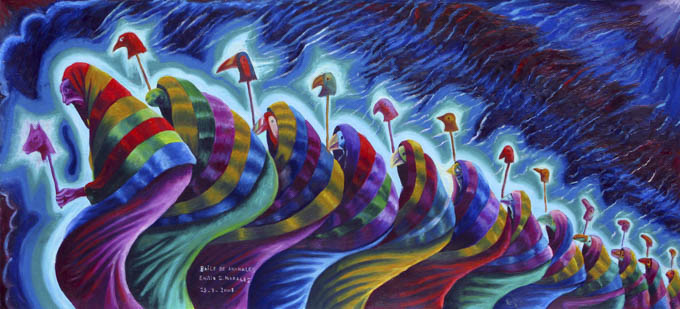|
Dance of Animals by Emilio González Morales, 2008.
The Dance of the Animals (Baile de los Animales) is one of the traditional dances of Guatemala. The pre-Hispanic
Maya often wore elaborate headdresses that represented birds and animals for their ceremonies, and Dance of the Animals is a
continuation of these ancient traditions. Emilio’s painting is not a literal depiction of that dance, but something deeper—his
interpretation of the spirit of that dance.
In the Maya towns of Guatemala, the masked dancers customarily perform the dance in the courtyards of the houses of the different
cofradías, at the house of the mayor of the town, as well as in the street for the public. At each of these locations, the hosts
offer alcohol and food to the family or the cofradía. Since it is considered impolite to refuse the drink, the dancers become quite
inebriated. As a result, they often go into a trance where they feel that the spirit of the animal—its nawal—takes over.
In Emilio’s painting, the dancers are not men, but the animals and birds themselves. Each dancer carries a ceremonial staff or vara,
the head of which represents the head of the animal. The vara symbolizes the presence, power, and authority of the ancestors. The
birds and animals all wear the traje (traditional attire) of Maya women—a perraje (shawl) and a corte (skirt). The animals in the
painting line up, more like a procession than a dance. The sky is dark, and the wind blows over the heads of the dancers. On this
night the animals, or perhaps their nawales, have taken on human characteristics for their dance.
|
